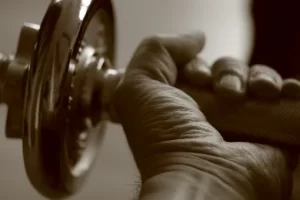dumbbell set
Dumbbell Fly to Give Your Chest That Strong and Built Look
When it comes to exercising, aesthetic appearances have become as important as feeling strong and healthy. If you are looking to build a toned, muscular and strong upper body, the dumbbell fly exercise is one type of movement you can practice to achieve that.
Although not as popular among bodybuilding enthusiasts as the bench press or barbell for a chest workout, the dumbbell fly exercise offers more as it stretches the pectoral muscles beyond just the chest. This particular exercise focuses on developing the chest’s pectoral muscles, attached to the sternum, by repeating a set of movements with the dumbbells. Repeated movements resemble the flapping of a flying bird’s wings that explains the term “ dumbbell chest fly .”
What muscles do dumbbell chest flyes work?
The dumbbell chest fly is an effective weight-training exercise that strengthens the upper body and enhances the physique. Dumbbell chest fly works the chest muscles primarily but extends to other upper body parts as listed below.
- Chest
The dumbbell chest fly, as the name suggests, focuses on working the chest muscles. Specifically, the muscles of the pectoralis major, commonly known as pecs, are the target. The pecs comprise the upper chest and span across the middle and then the lower chest.
- Shoulders
Shoulders joints are also primarily targeted muscles in the dumbbell chest fly exercise as they are stretched to enable repeated back and forth movements of the arms. Movements in the dumbbell fly exercise isolate the muscles in the chest and shoulders. Muscles that are worked in the shoulders are called deltoids.
- Triceps
There may be various types of exercises for triceps, but dumbbell flyes are beneficial such that they work the entirety of the triceps. Triceps comprise three heads that are utilized in this exercise.
- Biceps
Biceps are worked to a lesser extent than other muscles, but these muscles play a vital role in ensuring steady movements and proper form.
- Back
Between bringing the dumbbells to the chest and the elbows in parallel to the back, the repeated motions of the dumbbell flyes utilize the back muscles in tandem with the shoulders.

Dumbbell Flye Variations
Fly exercises are typically performed using cables, but dumbbells offer a simpler substitute with similar benefits. Numerous variations of dumbbell flye exercises are used by fitness enthusiasts that differ by the muscle segments targeted, purpose and intent, some of which are listed below.
- Dumbbell Chest Flye
Dumbbell chest flye consists of lying on your back on a flat bench with dumbbells in your hands and moving your arms inwards and outwards in repeated motions, keeping your feet at the shoulder-width distance on the ground surface. The exercise focuses on chest-building but also works the muscles in the shoulders and triceps. Other benefits of dumbbell chest flye include upper back pain relief and loosening the muscle tightness in the chest.
- Gym Ball Dumbbell Flye
This variation of dumbbell flye constitutes an exercise ball on which the exerciser lies their back. The inclusion of the exercise ball increases the difficulty level of the exercise by a step. Due to the unstable movements of the ball, it is recommended to opt for a dumbbell of lighter weight. Rear and side deltoids alongside upper pectoral muscles are the prime targets in gym ball dumbbell flye. However, the muscles trained in this exercise are subjective to movements and techniques used. Other benefits include developing core strength and improving balance as the muscles of the entire body are utilized.
- Incline Dumbbell Flye
Incline Dumbbell Flye is performed on an exercise bench inclined at an approximated angle of 30 degrees. Muscles in the upper chest or the upper pecs are trained in this dumbbell flye variation instead of the flat bench exercises that work only on the middle chest. It is advantageous if you are seeking to develop your upper body strength.
- Standing Dumbell Flye
Another name for standing dumbbell flye is dumbbell lateral flye. It involves the motion of the entire body. Unlike its counterparts, namely dumbbell chest fly and incline dumbbell flye, this variation is performed in a standing position. It targets the muscles in the chest, shoulders and triceps.
How To Do The Dumbbell Flye
- Dumbbell Chest Fly
Step 1:
Lie down on a flat bench with your face upwards and hold a pair of dumbbells on the top of your thighs at rest. The dumbbells should not weigh more than 45lbs.
Step 2:
Push your thighs to bring the dumbbells from the resting position to your chest. Hold the dumbbells apart at a distance equal to the shoulder width.
Step 3:
Push the dumbbells in the upward direction and stop the movement before the lockout position.
Step 4:
Next, lower your arms along with the dumbbells by bending them at your elbows until your chest is stretched.
Step 5:
Squeeze the muscles in your chest and return to the initial position.
- Incline Bench Chest Fly
Step 1:
Hold a dumbbell pair and lie down on a bench inclined at an approximated 30 degrees.
Step 2:
Bend your elbows a little and proceed to extend your arms in the upward direction on top of yourself. Ensure that the position of your wrists is neutral. Otherwise, twist your wrists to bring them to the neutral position.
Step 3:
Slowly, bring your arms down and lower them such that the dumbbells are by your sides at the end of this step. Ensure that your palms are in the upward direction.
Step 4:
Repeat the movement in reverse such that the dumbbells are at the initial position.
- Standing Dumbbell Fly
Step 1:
Grab a pair of dumbbells and hold them at an arms’ length in a neutral grip. Ensure that the arms are by your sides and palms facing in your direction.
Step 2:
Bend your elbows a little and bring the dumbbells to your torso laterally without any swing in your movements.
Step 3:
Keep on pulling the dumbbells upwards until the surface of the ground and your arms become parallel.
Step 4:
Hold your position for one to two seconds.
Step 5:
Return the dumbbells to the initial position by bringing them to your sides.
Dumbbell Flyes Tips
Dumbbell chest flys and their variations are not easy exercises to implement. Improper movements can lead to severe injuries that can be avoided with proper form and precise techniques. Take a look at some of the tips below to prevent yourself from any bodily damage.
- Dumbbell Chest Fly
· Ensure that only your shoulder joints are used for movements. Your arms should remain steady.
· Maintain a firm grip but not too tightly as it can decrease the work on your pectoral muscles.
· Avoid overarching your lower back.
· Ensure that your feet are flat against the ground surface.
· Keep your elbows bent to engage the pectoral muscles.
- Incline Bench Chest Fly
· Do not move your elbows.
· Avoid the dumbbells from touching on top, so only the primary muscles are targeted.
· Ensure that your form is proper to prevent injuries and obtain results.
- Standing Dumbbell Fly
· In each repetition, move your arms to your sides slowly and gradually.
· Use your shoulders when lifting the dumbbells to work the deltoids.


